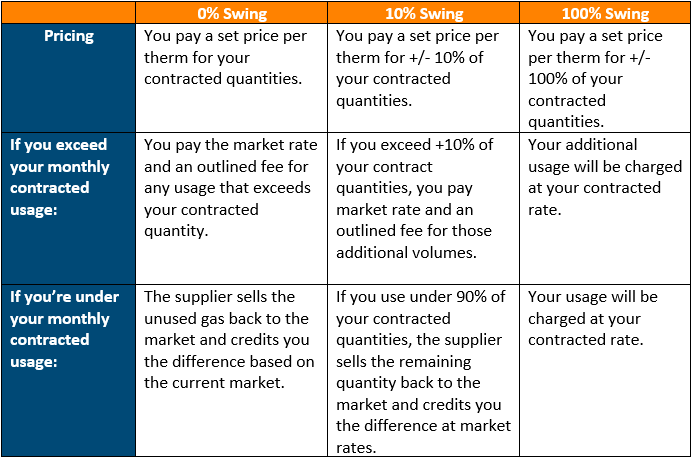- May 28, 2019

By Mike Eckenroth
When you look at natural gas bids, it can be a struggle to accurately compare pricing between suppliers. There’s no standard offering for natural gas pricing.
Which can lead to a lot of questions. The 5 most common natural gas questions we’re asked are:
- What’s the difference between Citygate and Burner Tip?
- Which delivery option is better: Citygate or Burner Tip?
- What is swing percentage?
- What’s different about 100% swing?
- Which swing percentage is best?
Below, we’ve answered these questions in a way that will boost your natural gas knowledge and give you the confidence to make a better buying decision for your company.
What’s the Difference Between Citygate and Burner Tip?
“Citygate” is the physical location where natural gas is delivered to a local distribution company (such as Nicor or BGE) via pipelines. “Burner Tip” refers to the point at which the gas is used as fuel.
When it comes to your natural gas rate, the difference between the two lies in how a supplier charges for gas that is lost during transport.
This about it like this:
Imagine you pour exactly 1 gallon of water through a hose. When you measure the amount of water you get on the other side, it will never measure out to exactly 1 gallon. It’ll be close, but it will always be less than 1 gallon because some of the water will leak out or stick to the inside of the hose.
The same thing happens with natural gas. When gas is transported through pipelines to your facility, a small portion of it is lost during the trip due to leaks. This gas is called “lost and unaccounted for gas,” or LUAF.
A Burner Tip rate includes an additional charge to compensate for the lost gas — Citygate does not. Therefore, the supplier with the Citygate rate will charge you a fee separate from your rate to compensate for the losses.
If a supplier does not specify whether a bid is Citygate or Burner Tip, ask!
Which Delivery Point Is Better: Citygate or Burner Tip?
From a performance standpoint, one option is not better than the other. However, you need to know which delivery point a supplier is using for their bid so you can analyze the rates.
If a supplier is presenting a Citygate price, add 1-3% to the price to have an accurate comparison to a Burner Tip quote.
What Is Swing Percentage?
Swing percentage is a component of natural gas pricing that dictates how far your usage can deviate from your monthly contracted quantities without incurring incremental charges. The most common swing options are 0%, 10%, and 100%.
How does my bill differ with each option?
The price for any usage deviation depends on which swing option you choose. Prices for swing options greater than 0% include risk premiums.
Below is a table that highlights how each swing option affects the price you pay.

What’s Different About 100% Swing?
With a 100% swing product, suppliers charge you the same rate regardless of how much natural gas you use. If you use significantly more or less natural gas than expected, the supplier bears the burden of purchasing or selling additional quantities at the market rate.
Because of this risk, suppliers will charge you a premium for 100% swing that’s included in your rate. The premium charged is a function of the amount of variability in your month-to-month natural gas purchases.
For example: If you mostly use natural gas for heat in the winter months (like a condominium association), your premium will be higher than the premium for a customer who uses the same amount of gas every month (like a manufacturer).
A supplier’s bid for a 0% swing product could appear lower than a bid at 100% swing. That difference is at least partially due to the premium included for 100% swing.
Which Swing Percentage Is Best?
To decide the swing percentage that’s best for you, you need to know your company’s risk tolerance. If you can tolerate risk and have a very predictable usage profile, your can choose a lower swing percentage and achieve a lower overall price than someone who opts for 100% swing. However, that is not a guarantee.
Budget-conscious organizations that use natural gas for heating, such as associations and non-profit organizations, benefit from a 100% swing product. They can set their budgets beforehand and plan for the year.
Organizations with more predictable natural gas usage, like manufacturers, are typically more risk tolerant and can stand to benefit financially from taking a lower swing percentage.
Know the Ins and Outs of Supplier Bids.
Understanding Citygate, Burner Tip, and swing percentage can drastically change how you analyze supplier bids. Knowing how these components impact your rate empowers you to become a better natural gas buyer. Keep in mind that not all suppliers can provide all options.
It’s important to get an apples-to-apples comparison — you should work with an energy advisor to include any necessary adjustments that will align supplier bids and ensure an accurate comparison. An advisor can also answer your questions and help you create an energy strategy that matches your risk tolerance and meets your goals. Give me a call to discuss how you can optimize your natural gas purchase.
About the Author
 Mike is an energy professional based out of Baltimore, Maryland, with a strong engineering and purchasing background. His specialties include energy efficiency and strategic commodity procurement. Growing up in the shadow of the Three Mile Island nuclear power plant, Mike has an intimate stake in a grid with safe, reliable, and cost-effective energy generation — which he leverages into an energy strategy that provides security for his clients.
Mike is an energy professional based out of Baltimore, Maryland, with a strong engineering and purchasing background. His specialties include energy efficiency and strategic commodity procurement. Growing up in the shadow of the Three Mile Island nuclear power plant, Mike has an intimate stake in a grid with safe, reliable, and cost-effective energy generation — which he leverages into an energy strategy that provides security for his clients.
You can reach Mike via email at meckenroth@naniaenergy.com or phone at (717) 679-3663.


